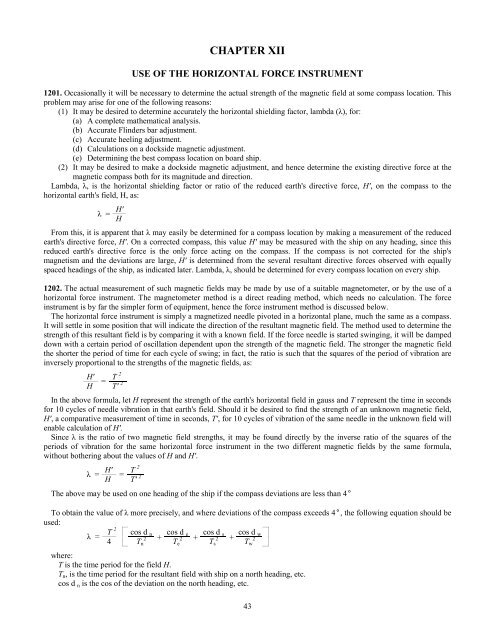Handbook of Magnetic Compass Adjustment - Maritime Safety ...
Handbook of Magnetic Compass Adjustment - Maritime Safety ...
Handbook of Magnetic Compass Adjustment - Maritime Safety ...
You also want an ePaper? Increase the reach of your titles
YUMPU automatically turns print PDFs into web optimized ePapers that Google loves.
CHAPTER XII<br />
USE OF THE HORIZONTAL FORCE INSTRUMENT<br />
1201. Occasionally it will be necessary to determine the actual strength <strong>of</strong> the magnetic field at some compass location. This<br />
problem may arise for one <strong>of</strong> the following reasons:<br />
(1) It may be desired to determine accurately the horizontal shielding factor, lambda (λ), for:<br />
(a) A complete mathematical analysis.<br />
(b) Accurate Flinders bar adjustment.<br />
(c) Accurate heeling adjustment.<br />
(d) Calculations on a dockside magnetic adjustment.<br />
(e) Determining the best compass location on board ship.<br />
(2) It may be desired to make a dockside magnetic adjustment, and hence determine the existing directive force at the<br />
magnetic compass both for its magnitude and direction.<br />
Lambda, λ, is the horizontal shielding factor or ratio <strong>of</strong> the reduced earth's directive force, H', on the compass to the<br />
horizontal earth's field, H, as:<br />
H'<br />
λ = H<br />
From this, it is apparent that λ may easily be determined for a compass location by making a measurement <strong>of</strong> the reduced<br />
earth's directive force, H'. On a corrected compass, this value H' may be measured with the ship on any heading, since this<br />
reduced earth's directive force is the only force acting on the compass. If the compass is not corrected for the ship's<br />
magnetism and the deviations are large, H' is determined from the several resultant directive forces observed with equally<br />
spaced headings <strong>of</strong> the ship, as indicated later. Lambda, λ, should be determined for every compass location on every ship.<br />
1202. The actual measurement <strong>of</strong> such magnetic fields may be made by use <strong>of</strong> a suitable magnetometer, or by the use <strong>of</strong> a<br />
horizontal force instrument. The magnetometer method is a direct reading method, which needs no calculation. The force<br />
instrument is by far the simpler form <strong>of</strong> equipment, hence the force instrument method is discussed below.<br />
The horizontal force instrument is simply a magnetized needle pivoted in a horizontal plane, much the same as a compass.<br />
It will settle in some position that will indicate the direction <strong>of</strong> the resultant magnetic field. The method used to determine the<br />
strength <strong>of</strong> this resultant field is by comparing it with a known field. If the force needle is started swinging, it will be damped<br />
down with a certain period <strong>of</strong> oscillation dependent upon the strength <strong>of</strong> the magnetic field. The stronger the magnetic field<br />
the shorter the period <strong>of</strong> time for each cycle <strong>of</strong> swing; in fact, the ratio is such that the squares <strong>of</strong> the period <strong>of</strong> vibration are<br />
inversely proportional to the strengths <strong>of</strong> the magnetic fields, as:<br />
H' T 2<br />
H = T' 2<br />
In the above formula, let H represent the strength <strong>of</strong> the earth's horizontal field in gauss and T represent the time in seconds<br />
for 10 cycles <strong>of</strong> needle vibration in that earth's field. Should it be desired to find the strength <strong>of</strong> an unknown magnetic field,<br />
H', a comparative measurement <strong>of</strong> time in seconds, T', for 10 cycles <strong>of</strong> vibration <strong>of</strong> the same needle in the unknown field will<br />
enable calculation <strong>of</strong> H'.<br />
Since λ is the ratio <strong>of</strong> two magnetic field strengths, it may be found directly by the inverse ratio <strong>of</strong> the squares <strong>of</strong> the<br />
periods <strong>of</strong> vibration for the same horizontal force instrument in the two different magnetic fields by the same formula,<br />
without bothering about the values <strong>of</strong> H and H'.<br />
H' T 2<br />
λ = = H T'<br />
2<br />
The above may be used on one heading <strong>of</strong> the ship if the compass deviations are less than 4°<br />
To obtain the value <strong>of</strong> λ more precisely, and where deviations <strong>of</strong> the compass exceeds 4°, the following equation should be<br />
used:<br />
T 2 cos d n cos d e cos d s cos d λ = w<br />
4<br />
2 Tn<br />
+ 2<br />
T<br />
+ 2<br />
e T<br />
+ 2<br />
s T w<br />
where:<br />
T is the time period for the field H.<br />
T n , is the time period for the resultant field with ship on a north heading, etc.<br />
cos d n is the cos <strong>of</strong> the deviation on the north heading, etc.<br />
43

















